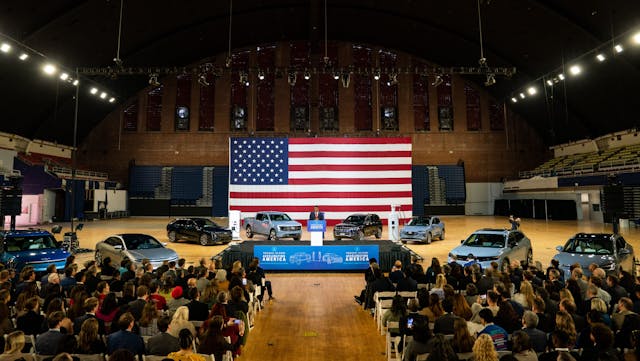New EPA Ruling Offers an Olive Branch to Opposing Sides, But Neither Are Happy
The new EPA proposals decidedly aren’t a 180-degree turn from the Biden Administration’s aggressive stance from last April that called for battery-electric vehicles to make up more than half of new-vehicle sales just six years from now, and two-thirds by 2032.
But Wednesday’s revision in those standards may indeed be a 90-degree shift from what Biden and the EPA wanted.
This new proposal now estimates that battery-electric cars, light trucks, and SUVs will make up 30 to 56 percent of new vehicle sales between 2030 and 2032, but even that may be ambitious unless cooling trends in electric vehicle demand warm up quickly. Though there are 83 battery-electric vehicles on the market, just two, the Tesla Model 3 and Model Y, accounted for 57 percent of retail new EV registrations across the industry in 2023.

Critics of the new proposal, including the National Automobile Dealers Association, say that even the softened guidance is “too aggressive and far ahead of consumer demand.” In 2023, according to data released last week by the S&P Mobility research firm, battery-electric vehicles made up 8.5 percent of new, light-duty vehicle registrations in the U.S. last year.
As you’d expect from the other end of the environmental spectrum, anti-pollution advocates criticize the reduced target because of what it might do to the fight to against carbon emissions. This is despite the fact that the new EPA proposal would set tougher limits on tailpipe pollution through 2032, and enable manufacturers to use other clean-ICE technology rather than just add more battery-electric vehicles. The new regulations also give more credit to the plug-in hybrid’s ability to trim pollution.
The EPA’s new rule slow-walks last April’s stricter pollution standards from 2026 to 2029 while increasing them up through 2032, ending up very nearly where last April’s initiatives would have landed, assuming this strategy works. It is lost on few that the election of Donald Trump in November might well cause a major re-write of Wednesday’s proposals.
Ralph Nader’s Public Citizen advocacy group claims that this new proposal “falls far short of what is needed to protect public health and our planet. EPA is giving automakers a pass to continue producing polluting vehicles,” Public Citizen says. “The Biden Administration had the opportunity to shift the automotive industry away from a model that’s driving record profits for automakers while literally killing us, toward one that still provides strong profits but keeps the world safer for humans.”

As it exists, the EPA’s proposal allows a manufacturer to sell ICE products, BEVs or PHEVs in whatever combination it chooses, as long as it makes its numbers. According to the EPA, a manufacturer should be able to sell between 30 and 56 percent BEVs in order to meet its pollution requirements. The new standard is based on grams-per-mile of emissions, not on the powerplant used.
Bottom line, the 1181-page document that covers the Biden Administration and the EPA’s new proposals—the “Final Rule” for vehicles “that will phase in over model years 2027 through 2032”—deftly offers something to both sides: A pause in having to worry as much about the timeline for the integration of battery-electric vehicles in a down-market EV sales atmosphere; and increasingly tough pollution standards that will, by 2055, prevent more than seven billion tons of carbon pollution from reaching the atmosphere.
So neither side is happy, but both can declare a win.
***
Check out the Hagerty Media homepage so you don’t miss a single story, or better yet, bookmark it. To get our best stories delivered right to your inbox, subscribe to our newsletters.



It’s “We the people” not “We the government”
Interesting to view comments about hybrids being “underpowered” and so forth. My wife needed a car with certain features, and the choice was between a Ford Fusion hybrid and a Honda Accord hybrid. I wanted an American car, but the Ford lacked a feature that the Honda had, and so the Honda came to live in our carport. This was in 2015. Wife passed in 2019, and the car has only a little over 36K miles on it, since I have another ICE vehicle that consumes more fuel than twice what the Honda sips. My records show that this car’s mileages range from 38.3 mpg (one time while new) to 47 and 52 mpg at the top end, with averages around 45mpg. Now, understand that I have a problem with the go pedal – it wants to go down a lot! If I behave myself, my around town trips have averaged from 60 mpg to 70 mpg, and a few times even a bit more. The problem that I have, is that I like to surprise fellow motorists with the acceleration and speed that this chameleon has under the bonnet. So, yes there are underpowered hybrids, but I would not classify this Honda Acord hybrid among them.